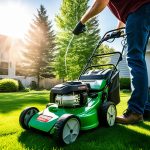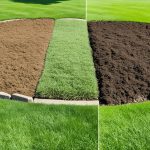Spring is approaching, and many homeowners are eager to start their lawn care routines. Knowing when to begin is crucial for achieving a lush, healthy yard throughout the growing season. The best time to start spring lawn care typically begins when temperatures consistently stay above 40°F (4°C) and the ground has thawed.
Before diving into lawn maintenance, it’s important to assess your yard’s current state. Look for signs of winter damage, such as bare patches or areas affected by snow mold. These issues may require specific attention before proceeding with regular care tasks.
Once conditions are suitable, you can begin preparing your lawn for the upcoming season. This includes gentle raking to remove dead grass and debris, aerating compacted soil, and addressing any drainage problems. Remember to wait until your grass has started actively growing before applying fertilizer or herbicides to avoid potential damage.
Key Takeaways
- Begin lawn care when temperatures consistently exceed 40°F and soil has thawed
- Assess winter damage and address specific issues before starting regular maintenance
- Prepare your lawn gradually, focusing on cleaning, aerating, and improving drainage
Assessing Your Lawn’s Current State
Evaluating your lawn’s health is a critical first step in spring lawn care. This process involves examining the soil composition and identifying the grass varieties present.
Conducting a Soil Test
Soil testing provides valuable insights into your lawn’s nutritional needs. Collect soil samples from various areas of your yard, avoiding recently fertilized spots. Send these samples to a local extension office or lab for analysis.
The test results will reveal the soil pH and nutrient levels. Most grasses thrive in slightly acidic soil with a pH between 6.0 and 7.0. If the pH is too low, add lime to increase it. For high pH, sulfur can help lower it.
Soil tests also indicate deficiencies in essential nutrients like nitrogen, phosphorus, and potassium. This information guides fertilizer selection and application rates for optimal grass growth.
Identifying Grass Type
Knowing your grass type is essential for proper care. Cool-season grasses like Kentucky bluegrass and fescue grow best in northern regions. They green up early in spring and tolerate cooler temperatures.
Warm-season grasses such as Bermuda and zoysia thrive in southern areas. These grasses remain dormant longer and prefer warmer soil temperatures to start growing.
Examine the blade width, color, and growth pattern to determine your grass type. Fine-bladed grasses with a bluish-green hue often indicate cool-season varieties. Coarser, lighter green blades typically suggest warm-season grasses.
Understanding your grass type helps in setting mowing heights and determining the best time to start spring maintenance tasks.
Preparing the Lawn for Spring
As winter fades, taking steps to ready your lawn for the growing season is essential. Proper preparation sets the stage for a lush, healthy yard throughout spring and summer.
Raking and Removing Thatch
Start by raking the lawn to remove dead grass, leaves, and debris that accumulated over winter. This process helps air and sunlight reach the soil and grass roots. Pay special attention to thatch – the layer of dead plant material between the soil surface and living grass.
If thatch exceeds 1/2 inch thick, it can block water and nutrients from reaching roots. Use a thatching rake or power dethatcher to break up and remove excess thatch. Rake up and dispose of the removed material.
For smaller lawns, a hand rake works well. Larger areas may benefit from a power rake rental. Be gentle to avoid damaging new grass growth.
Aerating Compacted Soil
Soil compaction restricts air, water, and nutrient movement to grass roots. Aerating creates small holes in the lawn to alleviate this issue. The best time to aerate is during your grass’s peak growing season – spring for cool-season grasses, late spring to early summer for warm-season varieties.
Use a core aerator that removes plugs of soil rather than just poking holes. Make several passes over the lawn in different directions. Leave the soil plugs on the grass to break down naturally, adding organic matter back into the soil.
For small lawns, manual aerators work well. Larger areas often require a machine rental. Water the lawn 1-2 days before aerating to soften the soil.
Seeding and Fertilizing
Spring is an ideal time to revitalize your lawn through strategic seeding and fertilizing. These practices can fill in bare spots and provide essential nutrients for robust grass growth.
Overseeding Sparse Areas
Overseeding helps thicken thin lawns and repair patchy spots. Choose grass seed that matches your existing turf type and is suited to your climate. Spring temperatures between 60°F and 75°F are optimal for seed germination. Rake the soil lightly before spreading seed to ensure good contact. Water the seeded areas consistently, keeping the soil moist but not waterlogged.
For best results, avoid applying pre-emergent herbicides when overseeding, as they can inhibit seed growth. Instead, focus on proper watering and soil preparation to give new grass the best chance to establish.
Applying the Right Fertilizer
Fertilizing in spring gives your lawn a nutrient boost as it enters the growing season. Select a fertilizer with a balanced ratio of nitrogen, phosphorus, and potassium. Nitrogen is particularly important for promoting green growth. Apply spring fertilizer when your grass starts actively growing, typically when soil temperatures reach about 55°F.
Cool-season grasses benefit from early spring fertilization, while warm-season grasses prefer fertilizer application in late spring. Use a spreader for even distribution and follow package instructions for application rates. Water the lawn after fertilizing to help nutrients reach the roots.
Lawn Mowing and Maintenance
Proper lawn mowing and maintenance are essential for a healthy, attractive yard. Regular mowing promotes grass growth and helps prevent weeds from taking over.
Determining the First Mow
The right time for the first mow of spring depends on grass type and local climate. Wait until grass reaches about 3 inches tall before cutting. This usually occurs when temperatures consistently stay above 40°F (4°C). Before mowing, clear debris and rake the lawn to remove dead grass and thatch.
Check soil moisture levels. Avoid mowing wet grass, as it can damage the turf and leave clumps. Test by walking on the lawn – if footprints remain visible, the ground is too wet. Mid-morning is often ideal for mowing, as morning dew has evaporated but the heat of the day hasn’t set in.
Establishing a Mowing Schedule
Once spring growth begins, maintain a regular mowing schedule. Frequency depends on grass type and growth rate, but once per week is common. Never remove more than one-third of the grass blade length in a single mowing session.
Adjust mowing height based on grass species:
- Cool-season grasses: 2.5-3.5 inches
- Warm-season grasses: 1-2 inches
Vary mowing patterns to prevent ruts and promote upright growth. Keep mower blades sharp for clean cuts that heal quickly.
Grasscycling for a Healthier Lawn
Grasscycling involves leaving grass clippings on the lawn after mowing. This practice returns nutrients to the soil, reducing fertilizer needs by up to 25%. It also helps retain soil moisture and can suppress weed growth.
To grasscycle effectively:
- Mow when grass is dry
- Cut frequently to avoid long clippings
- Use a mulching mower or mulching blade
- Spread out any clumps of grass
Grasscycling works best when clippings are short (less than 1 inch). If grass gets too long between mowings, collect and compost the clippings instead of leaving them on the lawn.
Integrated Weed and Pest Management
Effective lawn care requires a comprehensive approach to managing weeds and pests. By combining targeted treatments with preventive measures, homeowners can maintain a healthy, vibrant lawn throughout the spring and summer seasons.
Dealing with Common Weeds
Spring is a crucial time for weed control. Crabgrass and dandelions are two common invaders that can quickly take over a lawn if left unchecked. To combat these weeds, apply a pre-emergent herbicide in early spring before soil temperatures reach 55°F. This prevents weed seeds from germinating.
For existing weeds, post-emergent herbicides are effective. Many “weed and feed” products combine fertilizer with weed killers, offering a two-in-one solution. Always follow label instructions carefully when applying these products.
Proper mowing practices also help control weeds. Set mower blades to 2.5-3 inches high. This allows grass to shade the soil, reducing weed seed germination.
Preventing Pest Infestations
A healthy lawn is naturally resistant to pests. Proper watering is key – deep, infrequent irrigation encourages strong root growth. Water early in the morning to reduce moisture on grass blades, which can attract pests.
Regular mowing removes potential pest habitats. Avoid cutting grass too short, as this stresses the lawn and makes it more susceptible to infestations.
Beneficial insects like ladybugs and praying mantises can help control harmful pests. Encourage these natural predators by avoiding broad-spectrum insecticides.
For persistent pest problems, consider targeted treatments. Nematodes are effective against grubs, while Bacillus thuringiensis (Bt) controls certain caterpillars. Always identify the specific pest before treating.





